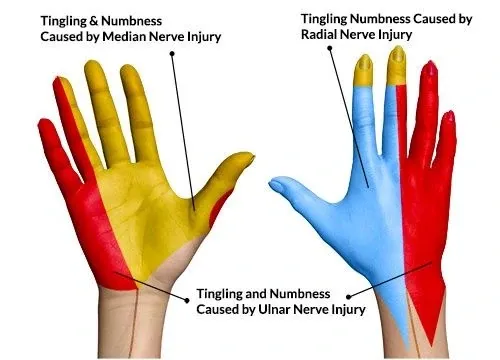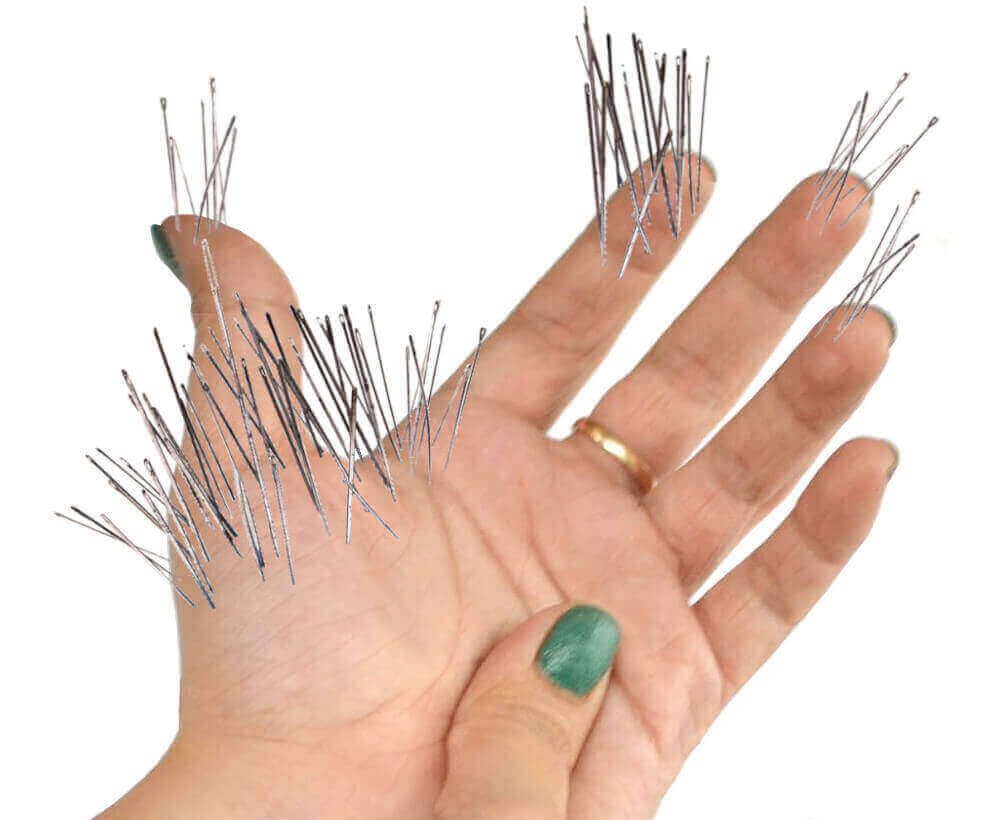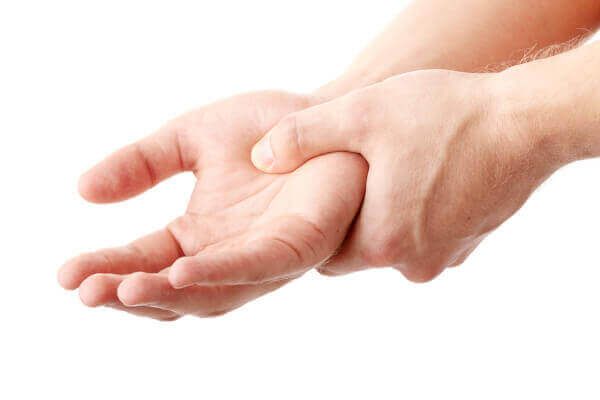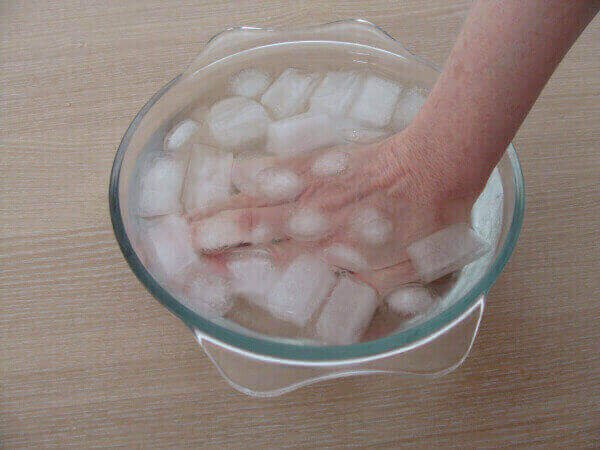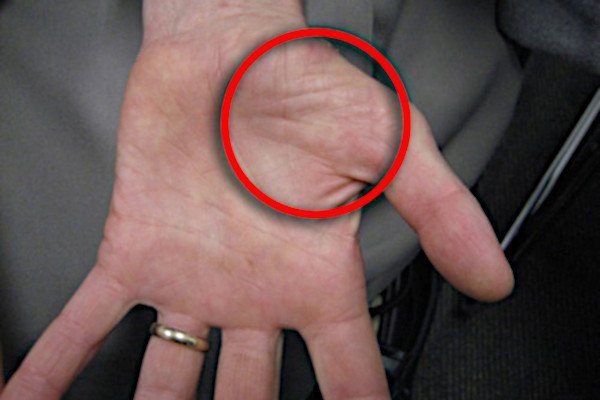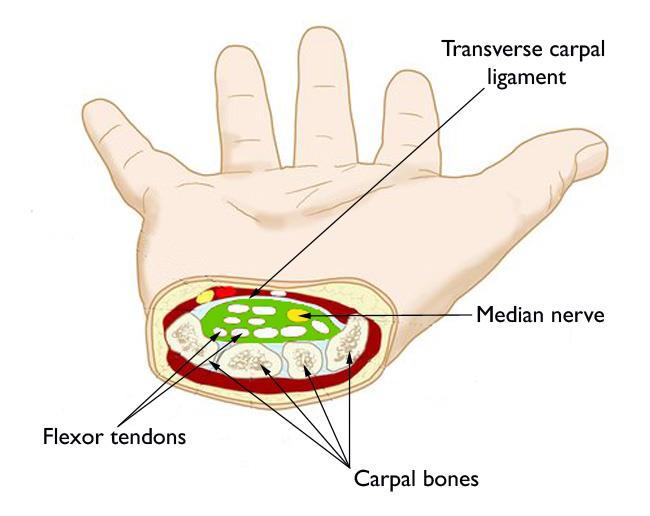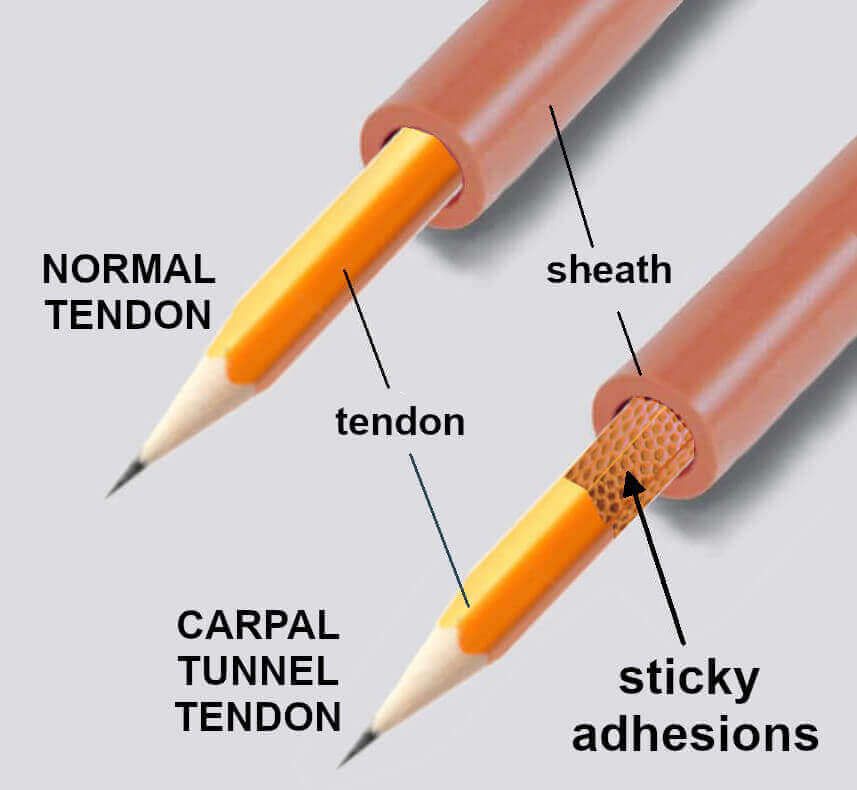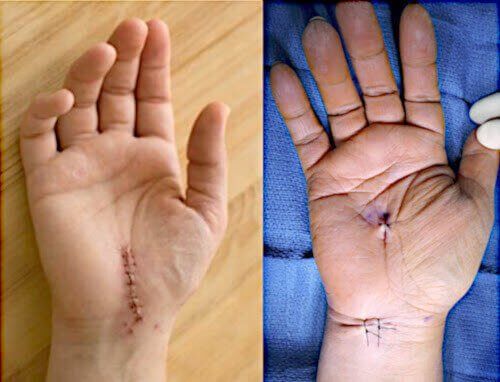Carpal Tunnel Symptoms & Causes
Table of Contents
- Diagnose it now because it usually worsens
- Most common carpal tunnel symptoms
- Where and how symptoms occur
1. MILD STAGE carpal tunnel symptoms
- MILD STAGE numbness or tingling
- MILD STAGE weakness
- MILD STAGE pain
2. MODERATE STAGE carpal tunnel symptoms
- MODERATE STAGE numbness or tingling
- MODERATE STAGE weakness
- MODERATE STAGE pain
- MODERATE STAGE loss of temperature sensation
3. SEVERE STAGE carpal tunnel symptoms
- SEVERE STAGE numbness or tingling
- SEVERE STAGE weakness
- SEVERE STAGE pain
- SEVERE STAGE loss of temperature sensation
- SEVERE STAGE (& End Stage) muscle loss
- Did you know carpal tunnel syndrome is incurable?
- Who's at risk for getting carpal tunnel?
- What causes carpal tunnel syndrome?
- What causes tendon swelling?
- The role of hand & finger activity
- Formation of microscopic rips & adhesions
- How to stop carpal tunnel
- Carpal tunnel release surgery
- Myofascial release massage
- Carpal tunnel diagnosis
- Physical exam/provocative tests
- Electrodiagnostics
- Imaging
- Summary
- About
The primary carpal tunnel symptoms to look for are straightforward and easy to spot. If your hand hurts or your fingers go numb, then you might have this condition.
But these symptoms alone aren't a definite diagnosis. That's because a few other hand problems can cause similar symptoms.
This article shows you how to tell if you have carpal tunnel syndrome and not something else.
Diagnose it now because it usually worsens
Carpal tunnel syndrome is a
progressive disorder. That means it
almost always
worsens without treatment in the majority of people who get it. If you let it advance to the
severe stage it's much more difficult to treat. Beyond that point, your hand may catastrophically affected, having only a fraction of its former function.
When you allow carpal tunnel to go that far, there's little chance anyone can fix the problem. That's because your median nerve is so damaged that it's too far gone for any repair
- even with surgery. The median nerve can get so damaged that it's essentially dead. At that point, surgeons know that any chance of repairing it is slight, at best.
Most common carpal tunnel symptoms
Most doctors classify carpal tunnel syndrome's severity in 3 distinct stages:
Within each of these stages, you can have one or more of the following symptoms:
Where and how symptoms occur
Carpal tunnel symptoms most frequently begin on the palm side of the index and middle fingers (see illustration above). Also, half of the ring finger has symptoms (on the thumb-side of that finger).
In most people, the thumb and forefinger are more severe than the other fingers. However, symptoms never appear on the fifth (little, or pinky) finger.
The remarkable thing about carpal tunnel it that while it can get extremely bad, it always starts off without your noticing anything at all. As symptoms start to show up more and more often, patients usually attribute it to overworked or tired hands. So in the beginning, it's hard to tell you have a major problem brewing! In fact, it's hard to tell the difference between carpal tunnel and simple
wrist tendinitis.
Unlike simple tired hands or even tendinitis, carpal tunnel symptoms
first happen during rest. In other words, they begin to appear when
you're sleeping or sitting quietly. In contrast, overworked hands or wrist tendonitis symptoms usually appear while actually using your hands.
The time it takes for carpal tunnel to progress from mild to severe is different from one person to another. But generally, it takes about 6 months.
The rate that symptoms worsen also varies. For instance, some see symptoms go from barely felt to severe in just a couple months. But in others it might take 2 or more years. Symptoms may also linger in a mild form for a long time (usually up to a year) and then worsen suddenly. Or symptoms could escalate steadily.
If symptoms start in one hand, then 80% of the time they'll also appear in the opposite hand. Doctors call this
bilateral carpal tunnel syndrome. Symptoms on the opposite hand can start simultaneously. But normally they appear within 6 months of each other.
1. MILD STAGE carpal tunnel symptoms
Mild Stage numbness or tingling
The early symptoms of carpal tunnel syndrome constitute the
mild stage of the condition. The most common early signs carpal tunnel are
numbness or tingling (also called "pins & needles") in the hands or fingers. Usually the fingertips are the first to feel numb or tingly.
Oftentimes, patients will describe a tingling or pins-and-needles feeling. Some patients may describe the tingling as
shooting
electric shocks in the index, middle or ring fingers. The electric shocks can shoot up the hand and into the arm.
Sometimes the numbness or tingling can travel from your wrist up your arm. These symptoms most often happen while holding a
steering wheel, phone, or newspaper. Bending your hand forward or back too far can produce finger numbness as well.
Other patients report constant
burning, itching or soreness. Others say their hand or fingers feel puffy. But the puffy feelings are
just feelings; there's usually no visible swelling or puffiness.
Usually numbness or tingling symptoms first appear when trying to sleep at night. Patients wake up with numbness and try to shake it out. As a result, many people lose sleep because they awaken and have to shake out their hands several times each night. This is the point where most patients realize they have a problem.
Mild Stage weakness
Patients in the mild stage may begin to see
weakness or
clumsiness
in their hands.
For example:
- There's a tendency to drop objects.
- Some patients find it difficult to open a jar, tie shoelaces, button a shirt, or pick up coins.
- Turning a doorknob is no longer a simple task.
Some of the weakness is due to reduced strength in your thumb muscles. The muscles used for pinching (controlled by the
median nerve) don't function due to the compressed median nerve (see below for more details).
Mild Stage pain
Even in the mild stage, pain can be a main symptom of this condition. It too will likely begin while trying to sleep.
Patients describe carpal tunnel pain differently. Some say the pain is dull and throbbing. Others say it's sharp and piercing. Yet others describe pain from carpal tunnel syndrome as a crushing feeling. They say their hand feels like it's in a vice. It's also common for patients to report pain radiating up their arm.
2. MODERATE STAGE carpal tunnel symptoms
As the median nerve inside the wrist becomes more and more damaged by swollen tendons (see below), carpal tunnel symptoms worsen. The hallmark of moderate stage carpal tunnel is when symptoms start to appear during daytime hours instead of only at rest or at night. Also, patients may begin to lose the sensation of hot or cold on their fingertips.
Moderate Stage numbness or tingling
These symptoms are nearly identical to those in the mild stage of carpal tunnel syndrome. The difference is that the symptoms are constant (happening day
and night) and are
more intense .
In addition, bending the hand forward or backward even a little makes symptoms much worse. Holding a phone or steering wheel usually worsens the problem.
Moderate Stage weakness
T
he strength of your hand continues to decline with moderate carpal tunnel syndrome. In fact,
loss of grip strength is one of the first complaints doctors hear.
The hand weakness at this stage makes it difficult to pick up heavier objects. Mothers can no longer pick up their child safely. Patients drop things more and more often. Holding a toothbrush or coffee cup is noticeably difficult.
Carpal tunnel syndrome usually affects the muscles at the base of thumb. So as the condition worsens, it's difficult to use your thumb fully. For instance, it's almost impossible to touch your thumb to your little finger.
Moderate Stage pain
I
f pain was not a mild stage sign, then it likely usually begins now, in the moderate stage. The pain sensations are similar to those described in the mild stage above, only more intense.
In the moderate stage, the level of pain can increase gradually or quickly. It may only be an annoying pain or else it can be crushingly severe. In this stage, pain may even take over numbness as the primary symptom. The pain will also likely be present day
and night.
Moderate Stage loss of temperature sensation
As carpal tunnel symptoms progress, most patients start to lose sensation of hot or cold on their fingers. The loss is usually not extremely severe at this stage, but it's noticeable. This is why doctors warn carpal tunnel patients to be extra-careful cooking or being around hot water. They can easily burn themselves.
3. SEVERE STAGE carpal tunnel symptoms
A sure sign that the condition is in the
severe stage
is when carpal tunnel symptoms are maximally uncomfortable or painful all day and all night. In general, that means there's no break from it. It has gone from an inconvenience to a major interference in your life.
The severe stage is when most patients ask to have surgery. But ironically, the more severe the carpal tunnel, the
less likelihood surgery will be successful.
Severe Stage numbness or tingling
The numbness in the severe stage is so intense it's the reason most people say they want to "cut their hand off" to relieve it. Also, the feeling of swollen or puffy fingers or hands may increase greatly.
It's most common for severe stage carpal tunnel patients to experience a combination of two or more symptoms. That means they can have any mixture of numbness, pain, burning, soreness, throbbing, itching, or tingling.
Some people try using ice baths to relieve the discomfort. However, ice baths provide only temporary relief, perhaps for 15 minutes.
Severe Stage weakness
When the condition progress to the severe stage, your hand function decreases dramatically. Overall loss of grip strength and dexterity dominates a patient's daily life. The hand is more clumsy and weaker than ever.
Fine dexterity also largely disappears. Many patients require assistance to bathe, toilet, and dress.
Severe Stage pain
t this point, any pain symptoms are usually constant. But even at the severe stage, finger or hand pain may never occur. That leaves only numbness or tingling feelings. But such is rare.
When pain is the predominant symptom, it's excruciating. Pain relievers like Tylenol or Advil are relatively useless.
Steroid shots can relieve pain, but the effect is usually temporary, lasting one to 4 months. Then the pain returns. Unfortunately, steroid shots can only be given in limited amounts due to their side effect
Severe Stage loss of temperature sensation
In the severe stage, the affected hand may get so numb that patients lose all ability to feel hot or cold. They must take extreme care around hot water or appliances. When loss of temperature sensation is so complete, almost any treatment (including surgery) to reverse carpal tunnel syndrome is usually unsuccessful.
Severe Stage (& End Stage) muscle loss
The end-stage of severe carpal tunnel syndrome is heralded by
advanced muscle loss. The muscles at the base of the thumb (thenar muscles) are in their final stages of degeneration. In other words, they slowly waste away.
That means there's noticeable muscle "wasting" (loss) or atrophy at the base of the thumb. The thumb muscles appear flat or wrinkled. Any useful function of the thumb and most of the fingers is almost impossible.
When this muscle wasting is complete, doctors classify you as being in the "end stage" of carpal tunnel syndrome.
Did you know carpal tunnel syndrome is incurable?
What most people (and even some doctors) don't appreciate is that carpal tunnel syndrome is
incurable. That's not to say you can't overcome it. In a way, it's like
diabetes. Nobody can cure diabetes. But with insulin and pills, you can treat it so that symptoms don't take over and rule your life.
Similarly, carpal tunnel can be treated quite effectively, too. You have both
surgical and
non-surgical options to choose from.
The key is to not allow carpal tunnel symptoms to get too far along. The quicker you treat it, the better your treatment results.
In the
mild
stage, carpal tunnel syndrome is relatively easy to treat. But having
severe
symptoms means the median nerve is already badly damaged. At that point it's much harder to treat.
Unfortunately, most people don't rush to treat carpal tunnel when it's in the mild stage. In fact, even though the
warning signs of carpal tunnel are well known, most people ignore them until the condition is in the severe stage.
The amazing fact is that early treatment is almost 100% successful when carpal tunnel is in the mild stage. In contrast, waiting and treating moderate or (worse) severe stage carpal tunnel syndrome is several times more difficult. And for certain, the outcome is not as good as treating it early.
Many people (and some doctors) delay treatment because they
confuse
carpal tunnel symptoms with
wrist tendinitis. And the vast majority of people just assume their hand is overworked or just tired. They believe with a little rest, the problem will go away. But it usually won't - and you've lost valuable therapy time.
Therefore, early treatment is key to attacking the problem before it worsens.
Who's at risk for getting carpal tunnel?
Absolutely
anybody can develop carpal tunnel syndrome. But some people are more prone than others. The major risk factors are:
What causes carpal tunnel syndrome?
Carpal tunnel syndrome's causes can vary. They range from how you work with your hands to your family history.
But at it's core, carpal tunnel syndrome is a problem with the
median nerve located deep inside your wrist joint. The nerve gets damaged due to compression by the tissues around it, especially the
flexor tendons.
The flexor tendons run next to the median nerve. They're the ropy structures in your hand that flex your fingers and allow them to grip. They compress the median nerve because they have a tendency to inflame and swell. It's that
swelling
which causes the compression on the nerve.
Gradual tendon swelling begins to push against the median nerve. As swelling increases, the tendons compress the nerve more and more.
Eventually, the swollen tendons crush the nerve completely.
What causes tendon swelling?
The role of hand & finger activity
Nobody is sure what makes flexor tendons swell in the first place. It's almost certainly set off by performing rapid, forceful or repetitive work with your hands. Repeated grip-and-release activities of the hand are among the greatest risk factors for getting carpal tunnel symptoms.
As a matter of fact, there are
certain jobs that are nearly synonymous with causing carpal tunnel syndrome. You wouldn't normally think about it, but
hair stylists, construction workers,
guitarists, cashiers,
video gamers, and
graphic artists all have two things in common.
- These occupations are notorious for requiring extensive hand and finger activity.
- These workers are particularly vulnerable to getting carpal tunnel.
But hand overwork isn't the whole story behind acquiring this condition. There's a huge body of evidence proving that carpal tunnel syndrome is
hereditary. If a parent or sibling has it, chances are very high that you will, too.
Formation of microscopic rips & adhesions
We get carpal tunnel symptoms because of everything that happens inside the confined space of the wrist joint. This space is called the carpal tunnel (see illustration above).
The end result is that swollen tendons crush the adjacent median nerve. This is the reason you have typical carpal tunnel symptoms like pain, numbness, tingling, soreness, or weakness in your fingers or hand.
But why do overworked tendons react that way? What chemistry or biology causes the inflammation that starts the swelling process?
Under normal conditions, tendons are very resilient. The can contract and relax thousands of times an hour. They can do this because each of them
glides smoothly
inside its own sheath (or covering). It's like a pencil gliding in and out of a plastic tube in the illustration below.
But in some people, overworking the tendons puts a toll on them. The strain produces numerous
microscopic
adhesions inside the tendon. These adhesions are like scars or scabs. They make the tendon sticky and less able to glide inside their sheath.
The body doesn't like these adhesions, and does it's best to eliminate them. So the body attacks them with cells and chemicals in order to get rid of them. This attack is what produces inflammation and subsequent swelling.
Eventually, the inflammation and swelling gets progressively worse The super-swollen tendons expand so much that they crush the adjacent median nerve.
How to stop carpal tunnel
Unfortunately, we cannot stop the adhesions from forming. But there are 2 things we can do to reduce the swelling and keep carpal tunnel symptoms from worsening.
Carpal tunnel release surgery
Myofascial release massage
Carpal tunnel diagnosis
Physical exam/provocative tests
During the physical exam, a doctors uses "provocative tests" to diagnose carpal tunnel syndrome. These are the
Phalen,
Tinel, and
Durkan
tests. They're called provocative tests because each test tries to provoke or enhance the symptoms you already have.
Click here to do these tests on yourself
The one thing these 3 tests have in common is that they're all "compressive" tests. In other words, they temporarily super-compress the median nerve. If symptoms can be provoked by doing that, it means you probably have carpal tunnel syndrome.
Today, most doctors have come to rely on the provocative tests because they can diagnose carpal tunnel syndrome with relatively high accuracy. If the examiner is experienced and consistent, their diagnosis can be
more accurate than any other diagnostic method, including electrodiagnostics (see next).
Electrodiagnostics
For the most part, patients with carpal tunnel syndrome show signs of nerve conduction abnormalities. This the reason doctors have historically relied on electrodiagnostic (or EDX) tests to confirm carpal tunnel syndrome. These tests mainly include the test for nerve conduction velocity (NCV) and electromyography (EMG).
Newer studies show these tests have too many
false positive results. That means the tests indicate carpal tunnel, when it is not actually the problem at all. For this reason, over recent years these tests have fallen out of favor with doctors.
Why is that important? It's because those patients who are
misdiagnosed as having carpal tunnel are
referred for hand surgery. But in reality, many don't have carpal tunnel syndrome at all, and therefore don't need carpal tunnel surgery!
What's more,
other studies show the provocative tests are better at diagnosing the condition. And provocative tests cost practically nothing compared to expensive and unnecessary EDX tests.
Imaging
MRI, X-ray, and ultrasound are not very reliable in predicting carpal tunnel syndrome. That's why they cannot be used as the
sole diagnosis
for this condition. In fact, they don't even approach the accuracy of the simple provocative tests. But many doctors still rely on medical imaging to confirm their diagnosis of carpal tunnel.
Lately, given their expense and the length of time they require to perform, a majority of doctors are not relying on imaging tests to confirm their carpal tunnel diagnosis.
Summary
Usually carpal tunnel symptoms begin as numbness and tingling in the hand and fingers. But some people begin feeling pain instead. As the condition progresses toward the severe stage, symptoms usually include intolerable numbness or excruciating pain. Patients will most likely also experience a loss of grip strength and dexterity. They also may lose the ability to sense hot and cold temperatures in their hand and fingers.
About


